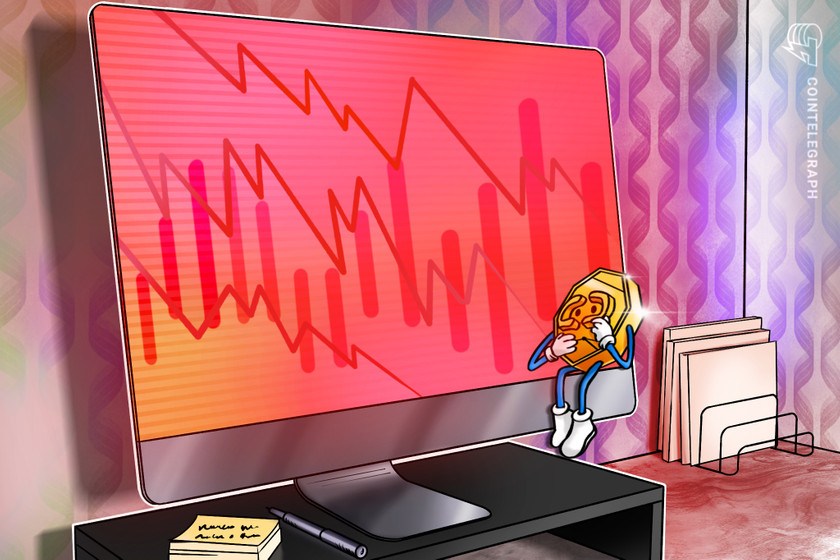Sam Bankman-Fried confronted over the fall of FTX in live interview


Sam Bankman-Fried was speaking at The New York Times’ DealBook Summit live on Nov. 30.
Former FTX CEO Sam Bankman-Fried has made his first live public appearance since the collapse of FTX — answering a number of questions during the DealBook Summit in New York on Nov. 30.
The hour-long interview was conducted on stage by New York Times journalist Andrew Sorkin, speaking to Bankman-Fried via video conference.
The pair discussed many subjects, including whether FTX and Alameda Research were commingling customer funds, what Bankman-Fried would say to customers who lost everything in FTX and whether he was concerned about being held criminally liable for its downfall.
Commingling of funds
In one of the earlier parts of the interview, Bankman-Fried claimed to have “unknowingly commingled funds” between Alameda and customer funds at FTX.
In this instance, the “commingling” referred to the customers’ funds deposited with FTX and loaned to its sister company Alameda. Sorkin referred to a submission sent in by a viewer earlier, which pointed out that this happened despite FTX’s terms of service stating that customers’ digital assets it holds are not its property and that it would not act as if they were.
Sorkin noted, “There appears to be a genuine commingling of the funds that are FTX customers’ that were not supposed to be commingled with your separate firm.”
Bankman-Fried, however, denied knowing about the commingled funds and blamed it on poor oversight.
“I unknowingly commingled funds. […] I was frankly surprised by how big Alameda’s position was, which points to another failure of oversight on my part and failure to appoint someone to be chiefly in charge of that,” said Bankman-Fried, adding:
“But I wasn’t trying to commingle funds.”
Bankman-Fried also appeared to deflect blame for the actions of Alameda, claiming he wasn’t privy to all the goings-on at the firm.
“I wasn’t running Alameda. I didn’t know exactly what [was] going on. I didn’t know the size of their position,” he said.
Criminal liability
Sorkin queried Bankman-Fried about whether he was concerned about his criminal liability at this point, which the former CEO responded to by suggesting it’s not his focus, noting:
“I don’t think that I personally have, you know, [criminal liability.] […] But I think the real answer is that’s not what I’m focusing on.”
Bankman-Fried continued to say that while he’s had a “bad month,” he’s not thinking about his own future, and what matters is trying to do everything he can to help customers and stakeholders of FTX.
He was also asked later in the interview what his lawyers were currently telling him and whether they thought he should be speaking in public.
To the laughter of the audience, Bankman-Fried replied “very much not,” and while suggesting he was given the classic advice of not to say anything, added:
“I have a duty to talk to people, I have a duty to explain what happened and I think I have a duty to do everything I can to try and do what’s right.”
Misleading the public
When asked when he knew there was a problem at FTX, Bankman-Fried suggested that “the time that I really knew there was a problem was November 6.”
However, some in the community have already pointed out that Bankman-Fried had said as recently as Nov. 7 — in a tweet that has since been deleted — that “FTX is fine. Assets are fine,” and had suggested that a competitor was “trying to go after us with false rumors.”
In another Nov. 7 now-deleted tweet, he asserted that FTX has enough to cover all client holdings, doesn’t invest client holdings and would continue to process all withdrawals.
Sorkin pressed Bankman-Fried on this point later in the interview, with the former CEO saying:
“When you look at November 6, I was feeling nervous, but I felt like things were probably going to end up okay.”
Sorkin also pressed Bankman-Fried on the funds that went missing from the exchange shortly after FTX filed for Chapter 11 bankruptcy, with the former FTX CEO briefly touching on this by giving the caveat that he was being cut off from FTX’s systems at this point.
He then went on to provide the “answer to the extent that I know it,” which was that the FTX US team and Bahamian regulators had both seized some, in addition to some “actual improper access,” which he could not provide details on.
Related: FTX proves MiCA should be passed fast, officials tell European Parliament committee
FTX famously imploded earlier this month after a liquidity crunch led to it halting customer withdrawals and subsequently filing for bankruptcy on Nov. 11.
The former ”white knight” of cryptocurrency has since shown up in a range of media appearances since he stepped down as CEO.
It is understood that much of the liquidity crisis was due to Alameda using client funds to cover loans that were being recalled due to the credit crunch caused by the collapse of Terra.



















